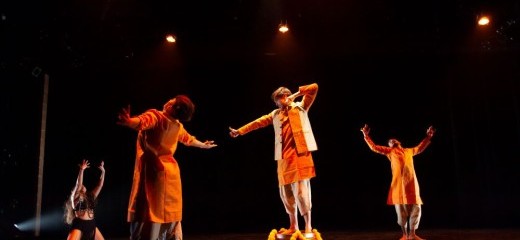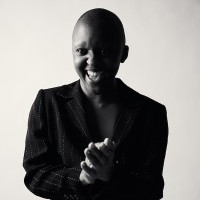
Ankita Sharma and Ke’Ron Wilson Choreograph Community
by Joy-Marie Thompson
At the Mare Nostrum Elements annual Emerging Choreographer’s Festival, several young up and coming choreographers were granted rehearsal space and funding to support their dancers to present new works. A culminating show presenting their latest work was featured at LaGuardia Performing Arts Center in Queens, NY. While this festival had promising and fresh talent, two artists’, Ankita Sharma and Ke’Ron Wilson stood out. Sharma’s choreography merges contemporary modern dance with classical Indian dance and Hindu myths to paint a scene that relates to current Indian political atmosphere while Wilson uses confessional text and voice overs from actual anti-trans speeches contrasts the care that is choreographed for the trans people’s bodies on stage. Both managed to use movement to detail important current events. But more importantly, they each share a glimpse into their own respective cultures and prioritize creating community with their dancers without any intention of their audience understanding.
“Aavaaz”, which translates from Hindi to “noise,” begins with darkness. One blade of light beams on Shavani Bagdi who is portraying Kali. She breathes heavily on stage. I imagine fire coming out of her mouth. As Bagdi’s eyes widen and her red tongue is revealed, choreographer and performer Ankita Sharma, along with dancers Isa and Blaize Adler-Ivanbrook, make their way down the Laguardia Performing Art Center’s Little Theater aisles towards this Kali, the warrior Hindu goddess whose name also means dark, or black. The three dancers start to direct woeful and grief stricken cries at Kali, convulsing at her feet while she steps at her altar. The stakes are high and Kali seems angry at this group of people. This is no ordinary contemporary dance. This is the work of a choreographer finding their voice through the use of their heritage to bring awareness to current issues that people, especially in the West may not know about.
Sharma’s “aavaaz” is an excerpt of an evening-long work titled “munh” which translates to “mouth.” While conservatism and radical violence toward marginalized folks is rising in our country, it is rising in other parts of the world as well. When Sharma spoke to me about their intention creating this particular work, they said, “...munh entangles Hindu goddess Kali’s myths with present-day authoritarianism, religious violence, and the West - specifically reflecting on violence against dark-skinned and Muslim people in South Asia and how that reflects worldwide.” Sharma’s choreography invokes a haunting despair of this present day trauma. Kali- dressed in black to symbolize an otherness in contrast to the three dancers dressed in orange- is full of rage. I assume they have done something to scorn this beautiful goddess of destruction; leading them into submission. In the climax of this piece, the three commoners surrounding the angry Kali thrust their hips and ribcage under her altar to the rhythm that she conveys.
While watching, I was very pleased to be embraced by the beautiful imagery of Hinduism portrayed by South Asian people, but a sense of grief bloomed in my chest regarding how contemporary choreography by Asian people is rarely represented. This lack of representation is something that Sharma is aware of, “...I get knocked for being intense, and this is something that is both intense and culturally-specific. I think that might be scary for people, which is exciting for me.” There is a certain kind of beauty that manifests when a brown skinned artist creates work about their people, not for the sake of wanting to garner Western/white, accolades, but rather to make a clear, stomping statement that reads “I am here and I am going to show you who my people are and what they are going through.” Ankita Sharma made no reservations when it came to that.
***
Ke’Ron J. Wilson’s “(Body Composition) In The Key of Spirit '' related me to another sense of grief as well. The piece features a trio of dancers: Wilson who also serves as the collaborative choreographer, Gabby Gubitosi, and Kabirah Lewis. It begins with each dancer present on stage in various positions while a soft spotlight highlights their bodies as they get dressed. While Lewis slips on a dress and Gubitosi adjusts his shirt and pants, their voices take over the speakers while they detail their spiritual journey by way of their own respective gender transitions. After they adjust their clothing, they find Wilson on the floor and embrace her in a group hug as Michael Knowles’s Conservative Political Action Conference speech plays in the background. All of us in the audience heard Knowles spew his words of hatred calling for the “eradication” of trans people. But what we saw was an intimate embrace of three trans people choosing love and care even in the threat of violence. It read as if they said:
Hey, I gotchu… things are really bad right now. But I see you and you are not alone. I will hold you/us through this.
For Wilson, the process of arriving at the work was, “more about crafting a relationship between communities. I needed to better understand how my cast related to themselves.” It was apparent that this process for this work required Wilson and her dancers to have deeply thoughtful conversations with each other. So, she proposed a question to her dancers. “The question became, ‘how did or does transitioning help you reach or align with a spirituality that you have?’ Specifically for the trans community it is very important for us to foster community in this way. It creates a new canon for how we view ourselves spiritually.”
It was a beautiful experience to witness Lewis and Wilson’s long, feminine legs reaching almost past the ceiling as Gubitosi remained a grounded masculine presence. Three trans people dancing for themselves.
Wilson says, “One of my joys in life is weaving, threading things together, [and] storytelling.” Aside from Wilson establishing a community of three during her process, this weaving and threading that she speaks of was present in the choreography. Throughout (Body Composition), the dancers' voiceovers detailing their connection to self and community were interlocked between sweeping solos that progressed into duets, trios, and back to solos again. Again, there is relief in witnessing a Black or brown choreographer who makes work for them and their community. So much of contemporary choreography, in fact, is made with an audience in mind to establish ethos. But this work was not made with me or any other audience member in mind. It was made for Wilson and her cast and I was a grateful audience member, happy to witness three people’s bodies who crafted a safe space for themselves; beckoning the audience to do the same. Once the piece was over, I rested my head on the back of my chair, wishing that an intermission would be cued after witnessing a world that I wish I lived in.
Mare Nostrum Elements: Emerging Choreographer Series, Ankita Sharma, Ke’Ron Wilson, LaGuardia Performing Arts Center, March 28-29 and Apr 2, 2023,
By Joy-Marie Thompson
April 19, 2023









